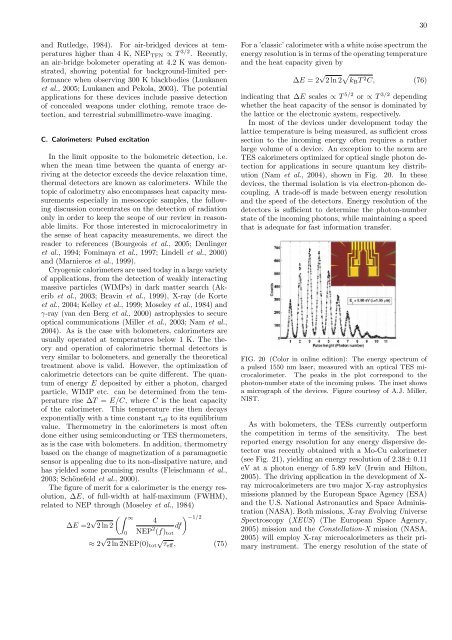Thermal properties in mesoscopics: physics and ... - ResearchGate
Thermal properties in mesoscopics: physics and ... - ResearchGate
Thermal properties in mesoscopics: physics and ... - ResearchGate
Create successful ePaper yourself
Turn your PDF publications into a flip-book with our unique Google optimized e-Paper software.
<strong>and</strong> Rutledge, 1984). For air-bridged devices at temperatures<br />
higher than 4 K, NEPTFN ∝ T 3/2 . Recently,<br />
an air-bridge bolometer operat<strong>in</strong>g at 4.2 K was demonstrated,<br />
show<strong>in</strong>g potential for background-limited performance<br />
when observ<strong>in</strong>g 300 K blackbodies (Luukanen<br />
et al., 2005; Luukanen <strong>and</strong> Pekola, 2003). The potential<br />
applications for these devices <strong>in</strong>clude passive detection<br />
of concealed weapons under cloth<strong>in</strong>g, remote trace detection,<br />
<strong>and</strong> terrestrial submillimetre-wave imag<strong>in</strong>g.<br />
C. Calorimeters: Pulsed excitation<br />
In the limit opposite to the bolometric detection, i.e.<br />
when the mean time between the quanta of energy arriv<strong>in</strong>g<br />
at the detector exceeds the device relaxation time,<br />
thermal detectors are known as calorimeters. While the<br />
topic of calorimetry also encompasses heat capacity measurements<br />
especially <strong>in</strong> mesoscopic samples, the follow<strong>in</strong>g<br />
discussion concentrates on the detection of radiation<br />
only <strong>in</strong> order to keep the scope of our review <strong>in</strong> reasonable<br />
limits. For those <strong>in</strong>terested <strong>in</strong> microcalorimetry <strong>in</strong><br />
the sense of heat capacity measurements, we direct the<br />
reader to references (Bourgeois et al., 2005; Denl<strong>in</strong>ger<br />
et al., 1994; Fom<strong>in</strong>aya et al., 1997; L<strong>in</strong>dell et al., 2000)<br />
<strong>and</strong> (Marnieros et al., 1999).<br />
Cryogenic calorimeters are used today <strong>in</strong> a large variety<br />
of applications, from the detection of weakly <strong>in</strong>teract<strong>in</strong>g<br />
massive particles (WIMPs) <strong>in</strong> dark matter search (Akerib<br />
et al., 2003; Brav<strong>in</strong> et al., 1999), X-ray (de Korte<br />
et al., 2004; Kelley et al., 1999; Moseley et al., 1984) <strong>and</strong><br />
γ-ray (van den Berg et al., 2000) astro<strong>physics</strong> to secure<br />
optical communications (Miller et al., 2003; Nam et al.,<br />
2004). As is the case with bolometers, calorimeters are<br />
usually operated at temperatures below 1 K. The theory<br />
<strong>and</strong> operation of calorimetric thermal detectors is<br />
very similar to bolometers, <strong>and</strong> generally the theoretical<br />
treatment above is valid. However, the optimization of<br />
calorimetric detectors can be quite different. The quantum<br />
of energy E deposited by either a photon, charged<br />
particle, WIMP etc. can be determ<strong>in</strong>ed from the temperature<br />
rise ∆T = E/C, where C is the heat capacity<br />
of the calorimeter. This temperature rise then decays<br />
exponentially with a time constant τeff to its equilibrium<br />
value. Thermometry <strong>in</strong> the calorimeters is most often<br />
done either us<strong>in</strong>g semiconduct<strong>in</strong>g or TES thermometers,<br />
as is the case with bolometers. In addition, thermometry<br />
based on the change of magnetization of a paramagnetic<br />
sensor is appeal<strong>in</strong>g due to its non-dissipative nature, <strong>and</strong><br />
has yielded some promis<strong>in</strong>g results (Fleischmann et al.,<br />
2003; Schönefeld et al., 2000).<br />
The figure of merit for a calorimeter is the energy resolution,<br />
∆E, of full-width at half-maximum (FWHM),<br />
related to NEP through (Moseley et al., 1984)<br />
∆E =2 √ 2 ln 2<br />
∞<br />
0<br />
4<br />
NEP 2 (f)tot<br />
df<br />
−1/2<br />
≈ 2 √ √<br />
2 ln 2NEP(0)tot τeff, (75)<br />
30<br />
For a ’classic’ calorimeter with a white noise spectrum the<br />
energy resolution is <strong>in</strong> terms of the operat<strong>in</strong>g temperature<br />
<strong>and</strong> the heat capacity given by<br />
∆E = 2 √ 2 ln 2 kBT 2 C, (76)<br />
<strong>in</strong>dicat<strong>in</strong>g that ∆E scales ∝ T 5/2 or ∝ T 3/2 depend<strong>in</strong>g<br />
whether the heat capacity of the sensor is dom<strong>in</strong>ated by<br />
the lattice or the electronic system, respectively.<br />
In most of the devices under development today the<br />
lattice temperature is be<strong>in</strong>g measured, as sufficient cross<br />
section to the <strong>in</strong>com<strong>in</strong>g energy often requires a rather<br />
large volume of a device. An exception to the norm are<br />
TES calorimeters optimized for optical s<strong>in</strong>gle photon detection<br />
for applications <strong>in</strong> secure quantum key distribution<br />
(Nam et al., 2004), shown <strong>in</strong> Fig. 20. In these<br />
devices, the thermal isolation is via electron-phonon decoupl<strong>in</strong>g.<br />
A trade-off is made between energy resolution<br />
<strong>and</strong> the speed of the detectors. Energy resolution of the<br />
detectors is sufficient to determ<strong>in</strong>e the photon-number<br />
state of the <strong>in</strong>com<strong>in</strong>g photons, while ma<strong>in</strong>ta<strong>in</strong><strong>in</strong>g a speed<br />
that is adequate for fast <strong>in</strong>formation transfer.<br />
FIG. 20 (Color <strong>in</strong> onl<strong>in</strong>e edition): The energy spectrum of<br />
a pulsed 1550 nm laser, measured with an optical TES microcalorimeter.<br />
The peaks <strong>in</strong> the plot correspond to the<br />
photon-number state of the <strong>in</strong>com<strong>in</strong>g pulses. The <strong>in</strong>set shows<br />
a micrograph of the devices. Figure courtesy of A.J. Miller,<br />
NIST.<br />
As with bolometers, the TESs currently outperform<br />
the competition <strong>in</strong> terms of the sensitivity. The best<br />
reported energy resolution for any energy dispersive detector<br />
was recently obta<strong>in</strong>ed with a Mo-Cu calorimeter<br />
(see Fig. 21), yield<strong>in</strong>g an energy resolution of 2.38± 0.11<br />
eV at a photon energy of 5.89 keV (Irw<strong>in</strong> <strong>and</strong> Hilton,<br />
2005). The driv<strong>in</strong>g application <strong>in</strong> the development of Xray<br />
microcalorimeters are two major X-ray astro<strong>physics</strong><br />
missions planned by the European Space Agency (ESA)<br />
<strong>and</strong> the U.S. National Astronautics <strong>and</strong> Space Adm<strong>in</strong>istration<br />
(NASA). Both missions, X-ray Evolv<strong>in</strong>g Universe<br />
Spectroscopy (XEUS) (The European Space Agency,<br />
2005) mission <strong>and</strong> the Constellation-X mission (NASA,<br />
2005) will employ X-ray microcalorimeters as their primary<br />
<strong>in</strong>strument. The energy resolution of the state of
















